Trends in Global Business: The Importance of Workplace Collaboration
VerifiedAdded on 2023/06/12
|11
|2807
|138
Essay
AI Summary
This essay examines the crucial role of workplace collaboration in the context of global business trends, particularly within the Australian business environment. It defines collaboration as a group of employees working together to achieve common organizational goals and highlights its importance in enhancing efficiency, productivity, and employee motivation. The essay identifies essential resources needed to support collaboration, including informational, social, and personal resources, and discusses challenges such as uneven workload distribution and potential performance decline among strong collaborators. Furthermore, it emphasizes the role of managers in steering positive collaboration through strategies like tracking employee assistance needs, rewarding effective teamwork, and potentially hiring chief collaboration officers. The conclusion underscores that fostering collaboration and strong employee relationships is vital for companies to thrive in today's competitive business landscape.
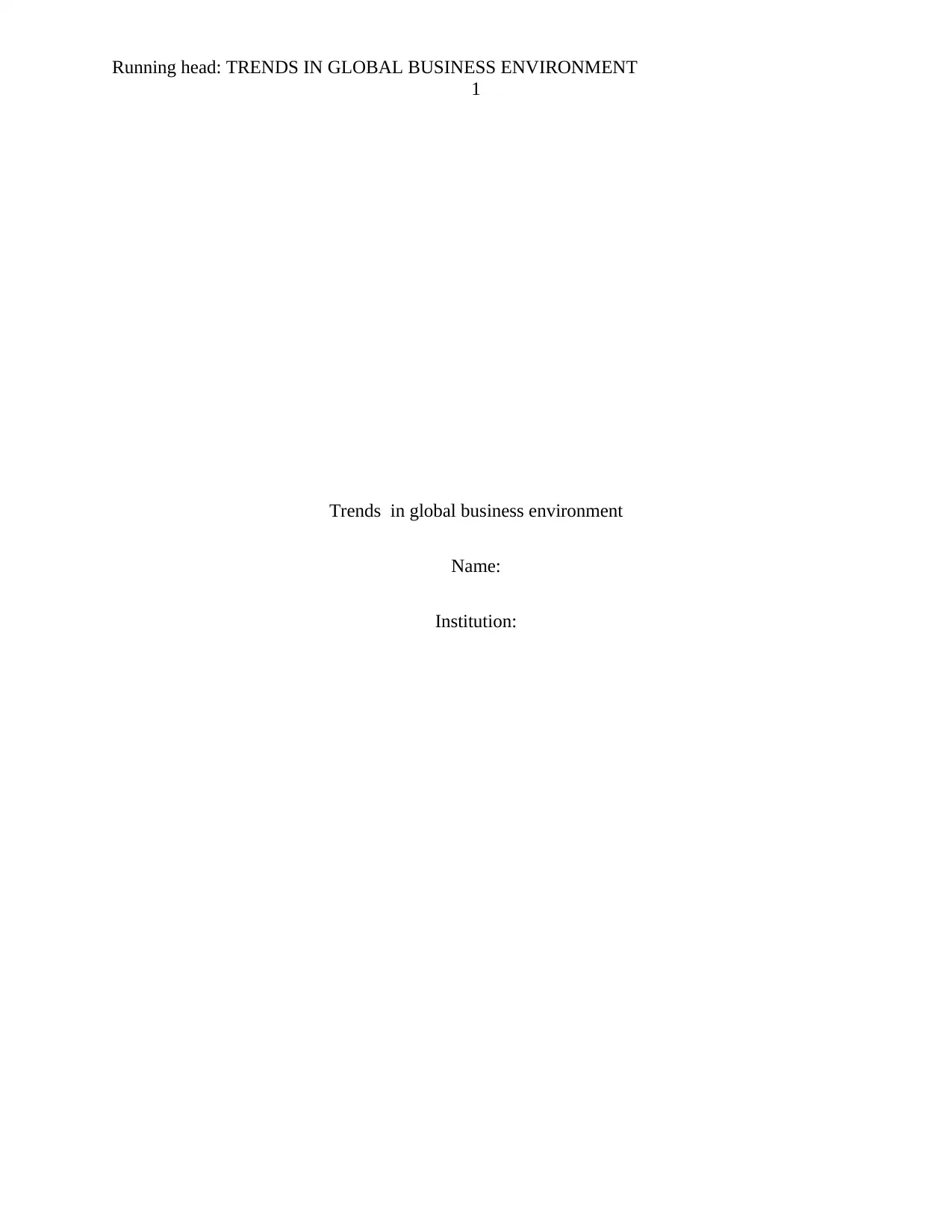
Running head: TRENDS IN GLOBAL BUSINESS ENVIRONMENT
1
Trends in global business environment
Name:
Institution:
1
Trends in global business environment
Name:
Institution:
Paraphrase This Document
Need a fresh take? Get an instant paraphrase of this document with our AI Paraphraser
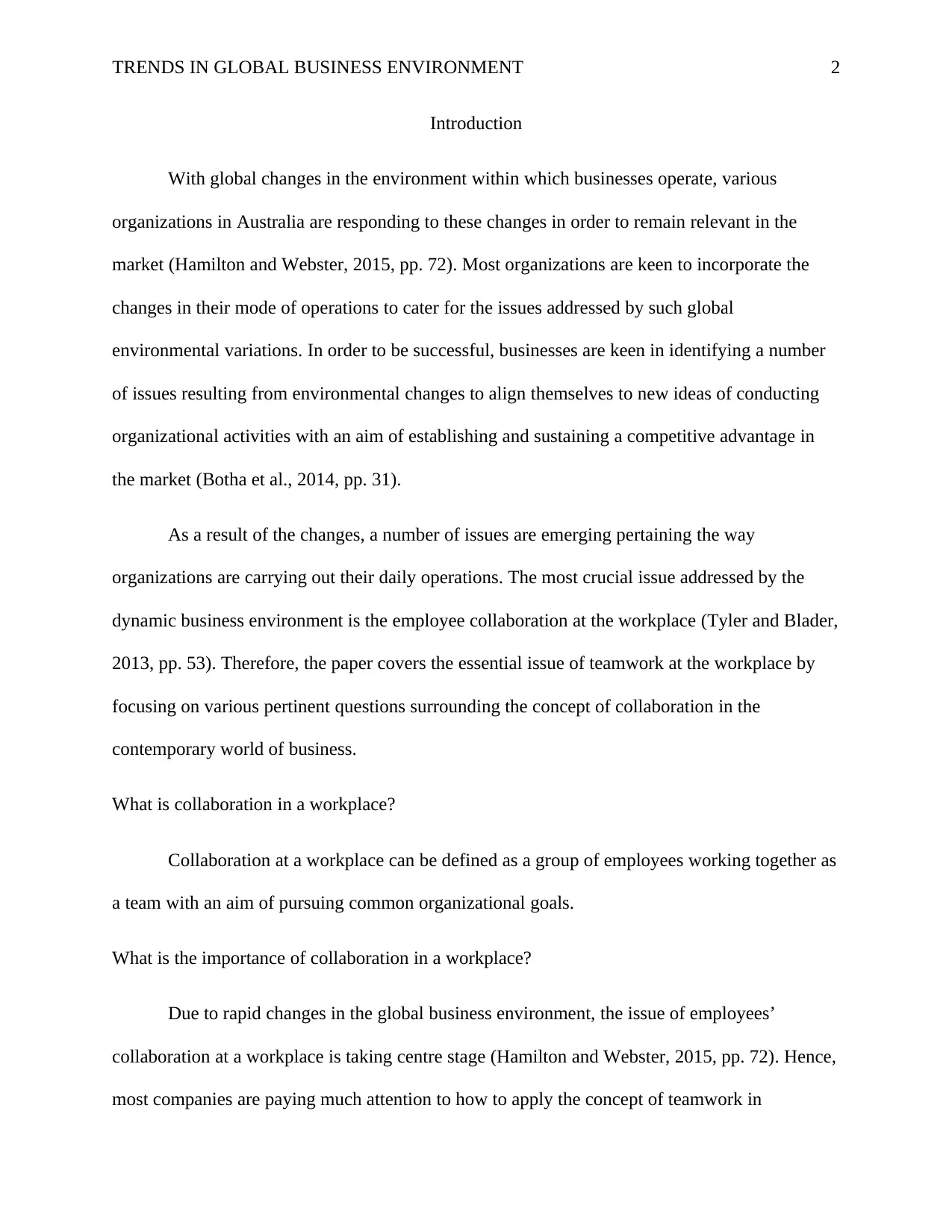
TRENDS IN GLOBAL BUSINESS ENVIRONMENT 2
Introduction
With global changes in the environment within which businesses operate, various
organizations in Australia are responding to these changes in order to remain relevant in the
market (Hamilton and Webster, 2015, pp. 72). Most organizations are keen to incorporate the
changes in their mode of operations to cater for the issues addressed by such global
environmental variations. In order to be successful, businesses are keen in identifying a number
of issues resulting from environmental changes to align themselves to new ideas of conducting
organizational activities with an aim of establishing and sustaining a competitive advantage in
the market (Botha et al., 2014, pp. 31).
As a result of the changes, a number of issues are emerging pertaining the way
organizations are carrying out their daily operations. The most crucial issue addressed by the
dynamic business environment is the employee collaboration at the workplace (Tyler and Blader,
2013, pp. 53). Therefore, the paper covers the essential issue of teamwork at the workplace by
focusing on various pertinent questions surrounding the concept of collaboration in the
contemporary world of business.
What is collaboration in a workplace?
Collaboration at a workplace can be defined as a group of employees working together as
a team with an aim of pursuing common organizational goals.
What is the importance of collaboration in a workplace?
Due to rapid changes in the global business environment, the issue of employees’
collaboration at a workplace is taking centre stage (Hamilton and Webster, 2015, pp. 72). Hence,
most companies are paying much attention to how to apply the concept of teamwork in
Introduction
With global changes in the environment within which businesses operate, various
organizations in Australia are responding to these changes in order to remain relevant in the
market (Hamilton and Webster, 2015, pp. 72). Most organizations are keen to incorporate the
changes in their mode of operations to cater for the issues addressed by such global
environmental variations. In order to be successful, businesses are keen in identifying a number
of issues resulting from environmental changes to align themselves to new ideas of conducting
organizational activities with an aim of establishing and sustaining a competitive advantage in
the market (Botha et al., 2014, pp. 31).
As a result of the changes, a number of issues are emerging pertaining the way
organizations are carrying out their daily operations. The most crucial issue addressed by the
dynamic business environment is the employee collaboration at the workplace (Tyler and Blader,
2013, pp. 53). Therefore, the paper covers the essential issue of teamwork at the workplace by
focusing on various pertinent questions surrounding the concept of collaboration in the
contemporary world of business.
What is collaboration in a workplace?
Collaboration at a workplace can be defined as a group of employees working together as
a team with an aim of pursuing common organizational goals.
What is the importance of collaboration in a workplace?
Due to rapid changes in the global business environment, the issue of employees’
collaboration at a workplace is taking centre stage (Hamilton and Webster, 2015, pp. 72). Hence,
most companies are paying much attention to how to apply the concept of teamwork in
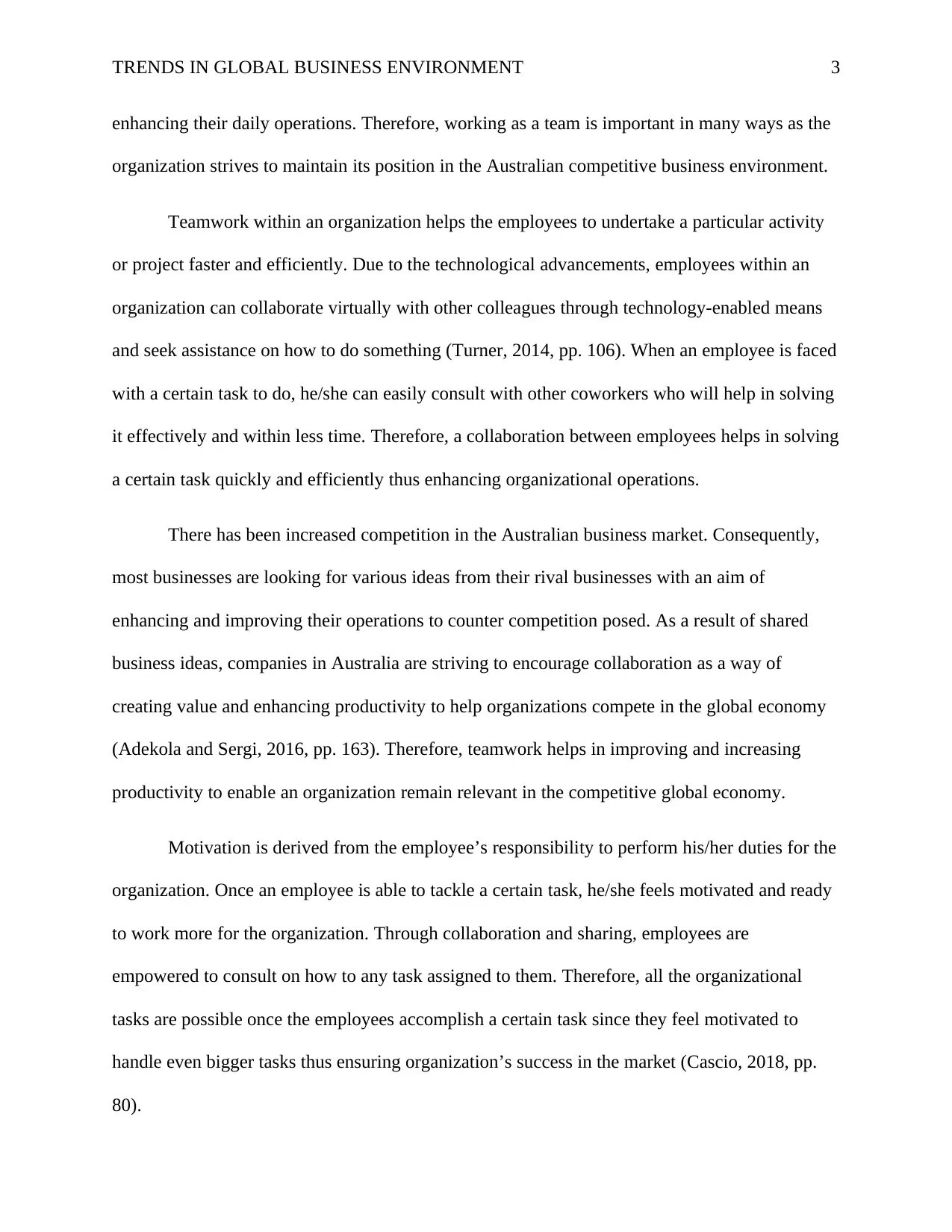
TRENDS IN GLOBAL BUSINESS ENVIRONMENT 3
enhancing their daily operations. Therefore, working as a team is important in many ways as the
organization strives to maintain its position in the Australian competitive business environment.
Teamwork within an organization helps the employees to undertake a particular activity
or project faster and efficiently. Due to the technological advancements, employees within an
organization can collaborate virtually with other colleagues through technology-enabled means
and seek assistance on how to do something (Turner, 2014, pp. 106). When an employee is faced
with a certain task to do, he/she can easily consult with other coworkers who will help in solving
it effectively and within less time. Therefore, a collaboration between employees helps in solving
a certain task quickly and efficiently thus enhancing organizational operations.
There has been increased competition in the Australian business market. Consequently,
most businesses are looking for various ideas from their rival businesses with an aim of
enhancing and improving their operations to counter competition posed. As a result of shared
business ideas, companies in Australia are striving to encourage collaboration as a way of
creating value and enhancing productivity to help organizations compete in the global economy
(Adekola and Sergi, 2016, pp. 163). Therefore, teamwork helps in improving and increasing
productivity to enable an organization remain relevant in the competitive global economy.
Motivation is derived from the employee’s responsibility to perform his/her duties for the
organization. Once an employee is able to tackle a certain task, he/she feels motivated and ready
to work more for the organization. Through collaboration and sharing, employees are
empowered to consult on how to any task assigned to them. Therefore, all the organizational
tasks are possible once the employees accomplish a certain task since they feel motivated to
handle even bigger tasks thus ensuring organization’s success in the market (Cascio, 2018, pp.
80).
enhancing their daily operations. Therefore, working as a team is important in many ways as the
organization strives to maintain its position in the Australian competitive business environment.
Teamwork within an organization helps the employees to undertake a particular activity
or project faster and efficiently. Due to the technological advancements, employees within an
organization can collaborate virtually with other colleagues through technology-enabled means
and seek assistance on how to do something (Turner, 2014, pp. 106). When an employee is faced
with a certain task to do, he/she can easily consult with other coworkers who will help in solving
it effectively and within less time. Therefore, a collaboration between employees helps in solving
a certain task quickly and efficiently thus enhancing organizational operations.
There has been increased competition in the Australian business market. Consequently,
most businesses are looking for various ideas from their rival businesses with an aim of
enhancing and improving their operations to counter competition posed. As a result of shared
business ideas, companies in Australia are striving to encourage collaboration as a way of
creating value and enhancing productivity to help organizations compete in the global economy
(Adekola and Sergi, 2016, pp. 163). Therefore, teamwork helps in improving and increasing
productivity to enable an organization remain relevant in the competitive global economy.
Motivation is derived from the employee’s responsibility to perform his/her duties for the
organization. Once an employee is able to tackle a certain task, he/she feels motivated and ready
to work more for the organization. Through collaboration and sharing, employees are
empowered to consult on how to any task assigned to them. Therefore, all the organizational
tasks are possible once the employees accomplish a certain task since they feel motivated to
handle even bigger tasks thus ensuring organization’s success in the market (Cascio, 2018, pp.
80).
⊘ This is a preview!⊘
Do you want full access?
Subscribe today to unlock all pages.

Trusted by 1+ million students worldwide
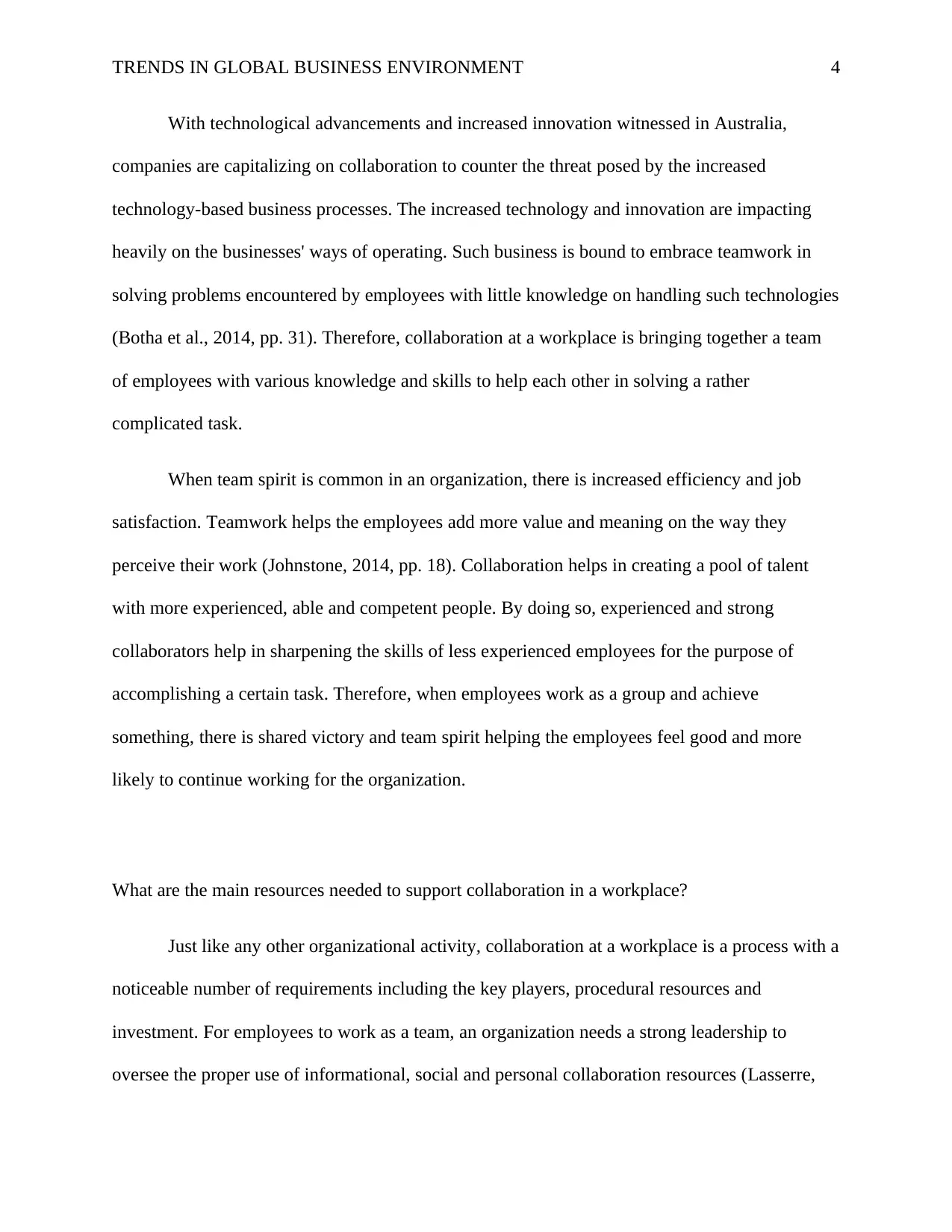
TRENDS IN GLOBAL BUSINESS ENVIRONMENT 4
With technological advancements and increased innovation witnessed in Australia,
companies are capitalizing on collaboration to counter the threat posed by the increased
technology-based business processes. The increased technology and innovation are impacting
heavily on the businesses' ways of operating. Such business is bound to embrace teamwork in
solving problems encountered by employees with little knowledge on handling such technologies
(Botha et al., 2014, pp. 31). Therefore, collaboration at a workplace is bringing together a team
of employees with various knowledge and skills to help each other in solving a rather
complicated task.
When team spirit is common in an organization, there is increased efficiency and job
satisfaction. Teamwork helps the employees add more value and meaning on the way they
perceive their work (Johnstone, 2014, pp. 18). Collaboration helps in creating a pool of talent
with more experienced, able and competent people. By doing so, experienced and strong
collaborators help in sharpening the skills of less experienced employees for the purpose of
accomplishing a certain task. Therefore, when employees work as a group and achieve
something, there is shared victory and team spirit helping the employees feel good and more
likely to continue working for the organization.
What are the main resources needed to support collaboration in a workplace?
Just like any other organizational activity, collaboration at a workplace is a process with a
noticeable number of requirements including the key players, procedural resources and
investment. For employees to work as a team, an organization needs a strong leadership to
oversee the proper use of informational, social and personal collaboration resources (Lasserre,
With technological advancements and increased innovation witnessed in Australia,
companies are capitalizing on collaboration to counter the threat posed by the increased
technology-based business processes. The increased technology and innovation are impacting
heavily on the businesses' ways of operating. Such business is bound to embrace teamwork in
solving problems encountered by employees with little knowledge on handling such technologies
(Botha et al., 2014, pp. 31). Therefore, collaboration at a workplace is bringing together a team
of employees with various knowledge and skills to help each other in solving a rather
complicated task.
When team spirit is common in an organization, there is increased efficiency and job
satisfaction. Teamwork helps the employees add more value and meaning on the way they
perceive their work (Johnstone, 2014, pp. 18). Collaboration helps in creating a pool of talent
with more experienced, able and competent people. By doing so, experienced and strong
collaborators help in sharpening the skills of less experienced employees for the purpose of
accomplishing a certain task. Therefore, when employees work as a group and achieve
something, there is shared victory and team spirit helping the employees feel good and more
likely to continue working for the organization.
What are the main resources needed to support collaboration in a workplace?
Just like any other organizational activity, collaboration at a workplace is a process with a
noticeable number of requirements including the key players, procedural resources and
investment. For employees to work as a team, an organization needs a strong leadership to
oversee the proper use of informational, social and personal collaboration resources (Lasserre,
Paraphrase This Document
Need a fresh take? Get an instant paraphrase of this document with our AI Paraphraser
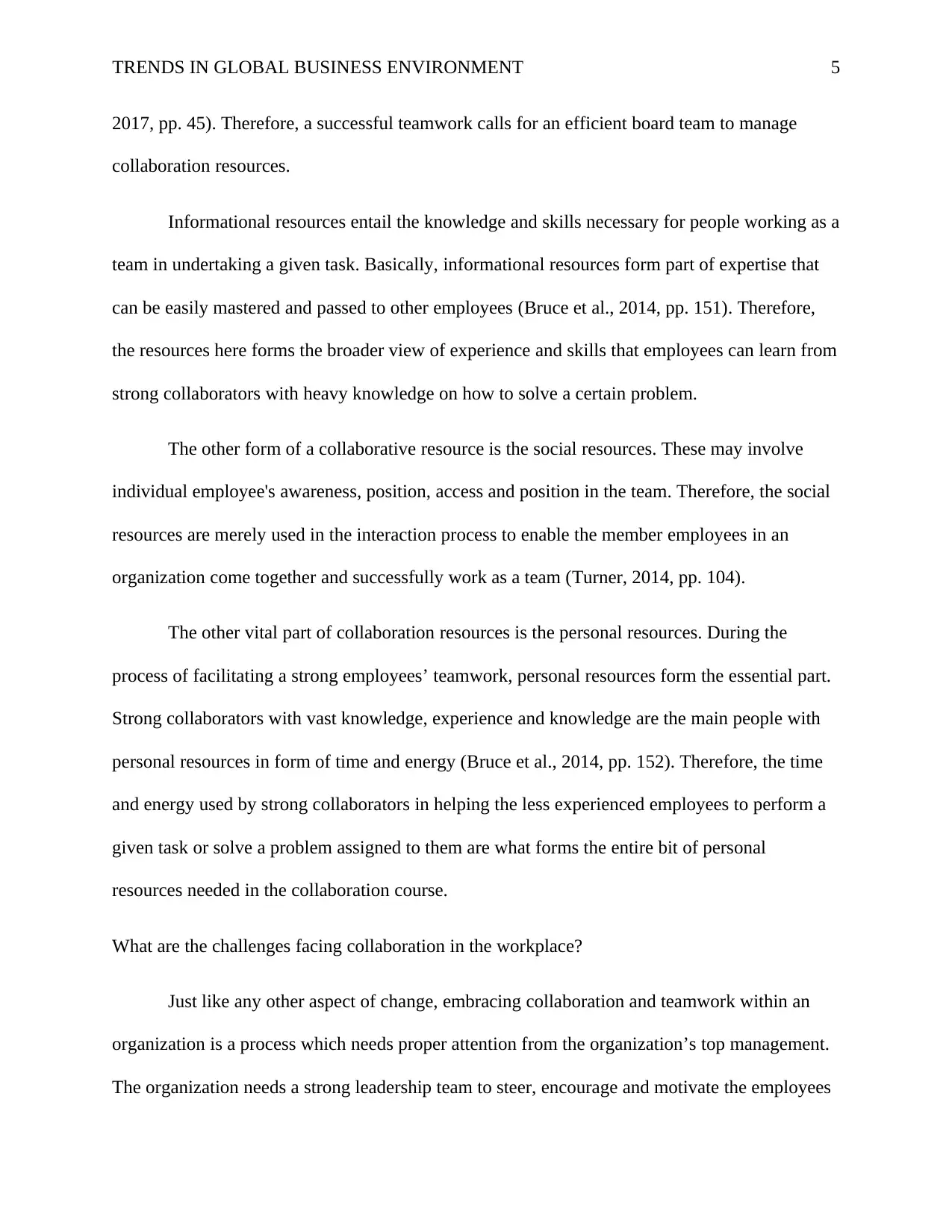
TRENDS IN GLOBAL BUSINESS ENVIRONMENT 5
2017, pp. 45). Therefore, a successful teamwork calls for an efficient board team to manage
collaboration resources.
Informational resources entail the knowledge and skills necessary for people working as a
team in undertaking a given task. Basically, informational resources form part of expertise that
can be easily mastered and passed to other employees (Bruce et al., 2014, pp. 151). Therefore,
the resources here forms the broader view of experience and skills that employees can learn from
strong collaborators with heavy knowledge on how to solve a certain problem.
The other form of a collaborative resource is the social resources. These may involve
individual employee's awareness, position, access and position in the team. Therefore, the social
resources are merely used in the interaction process to enable the member employees in an
organization come together and successfully work as a team (Turner, 2014, pp. 104).
The other vital part of collaboration resources is the personal resources. During the
process of facilitating a strong employees’ teamwork, personal resources form the essential part.
Strong collaborators with vast knowledge, experience and knowledge are the main people with
personal resources in form of time and energy (Bruce et al., 2014, pp. 152). Therefore, the time
and energy used by strong collaborators in helping the less experienced employees to perform a
given task or solve a problem assigned to them are what forms the entire bit of personal
resources needed in the collaboration course.
What are the challenges facing collaboration in the workplace?
Just like any other aspect of change, embracing collaboration and teamwork within an
organization is a process which needs proper attention from the organization’s top management.
The organization needs a strong leadership team to steer, encourage and motivate the employees
2017, pp. 45). Therefore, a successful teamwork calls for an efficient board team to manage
collaboration resources.
Informational resources entail the knowledge and skills necessary for people working as a
team in undertaking a given task. Basically, informational resources form part of expertise that
can be easily mastered and passed to other employees (Bruce et al., 2014, pp. 151). Therefore,
the resources here forms the broader view of experience and skills that employees can learn from
strong collaborators with heavy knowledge on how to solve a certain problem.
The other form of a collaborative resource is the social resources. These may involve
individual employee's awareness, position, access and position in the team. Therefore, the social
resources are merely used in the interaction process to enable the member employees in an
organization come together and successfully work as a team (Turner, 2014, pp. 104).
The other vital part of collaboration resources is the personal resources. During the
process of facilitating a strong employees’ teamwork, personal resources form the essential part.
Strong collaborators with vast knowledge, experience and knowledge are the main people with
personal resources in form of time and energy (Bruce et al., 2014, pp. 152). Therefore, the time
and energy used by strong collaborators in helping the less experienced employees to perform a
given task or solve a problem assigned to them are what forms the entire bit of personal
resources needed in the collaboration course.
What are the challenges facing collaboration in the workplace?
Just like any other aspect of change, embracing collaboration and teamwork within an
organization is a process which needs proper attention from the organization’s top management.
The organization needs a strong leadership team to steer, encourage and motivate the employees
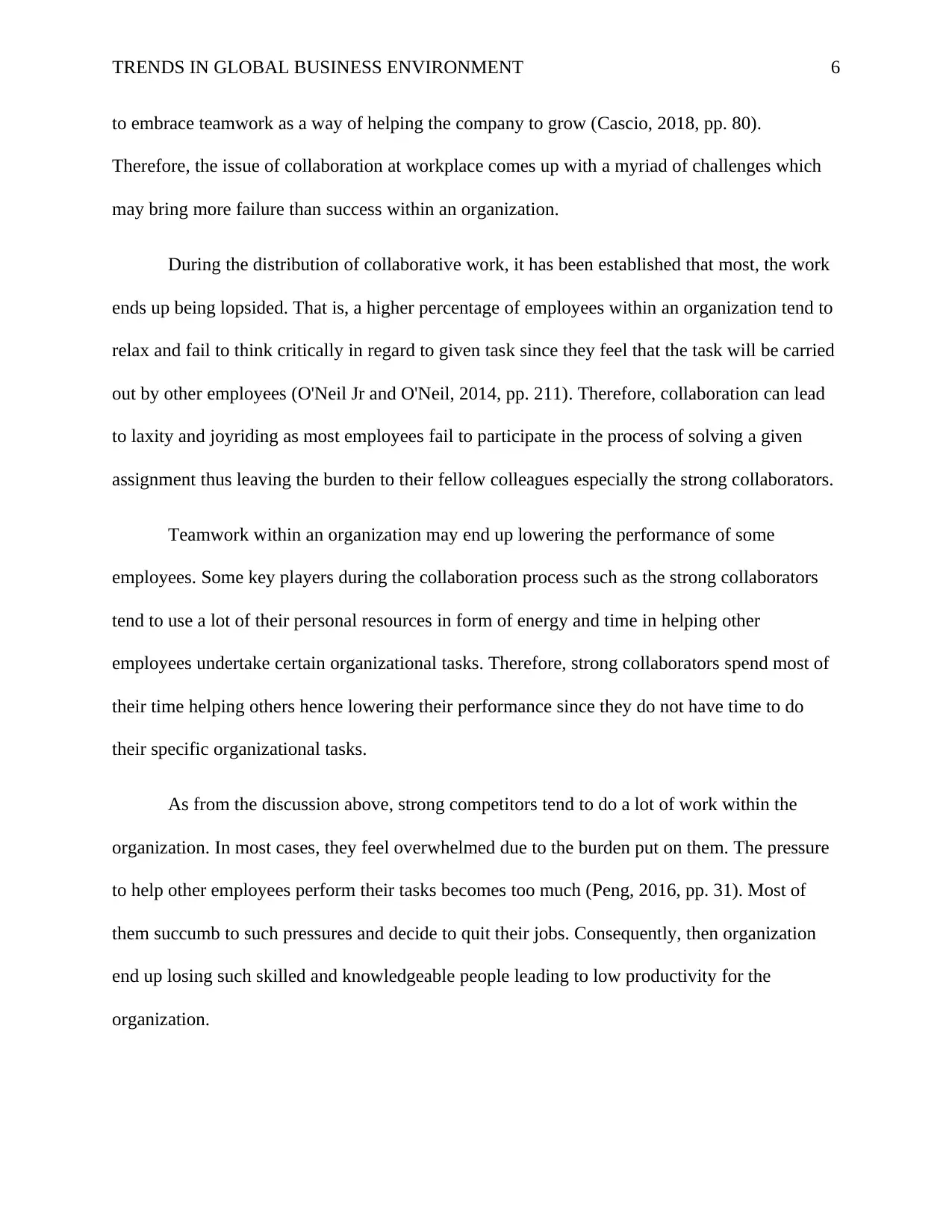
TRENDS IN GLOBAL BUSINESS ENVIRONMENT 6
to embrace teamwork as a way of helping the company to grow (Cascio, 2018, pp. 80).
Therefore, the issue of collaboration at workplace comes up with a myriad of challenges which
may bring more failure than success within an organization.
During the distribution of collaborative work, it has been established that most, the work
ends up being lopsided. That is, a higher percentage of employees within an organization tend to
relax and fail to think critically in regard to given task since they feel that the task will be carried
out by other employees (O'Neil Jr and O'Neil, 2014, pp. 211). Therefore, collaboration can lead
to laxity and joyriding as most employees fail to participate in the process of solving a given
assignment thus leaving the burden to their fellow colleagues especially the strong collaborators.
Teamwork within an organization may end up lowering the performance of some
employees. Some key players during the collaboration process such as the strong collaborators
tend to use a lot of their personal resources in form of energy and time in helping other
employees undertake certain organizational tasks. Therefore, strong collaborators spend most of
their time helping others hence lowering their performance since they do not have time to do
their specific organizational tasks.
As from the discussion above, strong competitors tend to do a lot of work within the
organization. In most cases, they feel overwhelmed due to the burden put on them. The pressure
to help other employees perform their tasks becomes too much (Peng, 2016, pp. 31). Most of
them succumb to such pressures and decide to quit their jobs. Consequently, then organization
end up losing such skilled and knowledgeable people leading to low productivity for the
organization.
to embrace teamwork as a way of helping the company to grow (Cascio, 2018, pp. 80).
Therefore, the issue of collaboration at workplace comes up with a myriad of challenges which
may bring more failure than success within an organization.
During the distribution of collaborative work, it has been established that most, the work
ends up being lopsided. That is, a higher percentage of employees within an organization tend to
relax and fail to think critically in regard to given task since they feel that the task will be carried
out by other employees (O'Neil Jr and O'Neil, 2014, pp. 211). Therefore, collaboration can lead
to laxity and joyriding as most employees fail to participate in the process of solving a given
assignment thus leaving the burden to their fellow colleagues especially the strong collaborators.
Teamwork within an organization may end up lowering the performance of some
employees. Some key players during the collaboration process such as the strong collaborators
tend to use a lot of their personal resources in form of energy and time in helping other
employees undertake certain organizational tasks. Therefore, strong collaborators spend most of
their time helping others hence lowering their performance since they do not have time to do
their specific organizational tasks.
As from the discussion above, strong competitors tend to do a lot of work within the
organization. In most cases, they feel overwhelmed due to the burden put on them. The pressure
to help other employees perform their tasks becomes too much (Peng, 2016, pp. 31). Most of
them succumb to such pressures and decide to quit their jobs. Consequently, then organization
end up losing such skilled and knowledgeable people leading to low productivity for the
organization.
⊘ This is a preview!⊘
Do you want full access?
Subscribe today to unlock all pages.

Trusted by 1+ million students worldwide
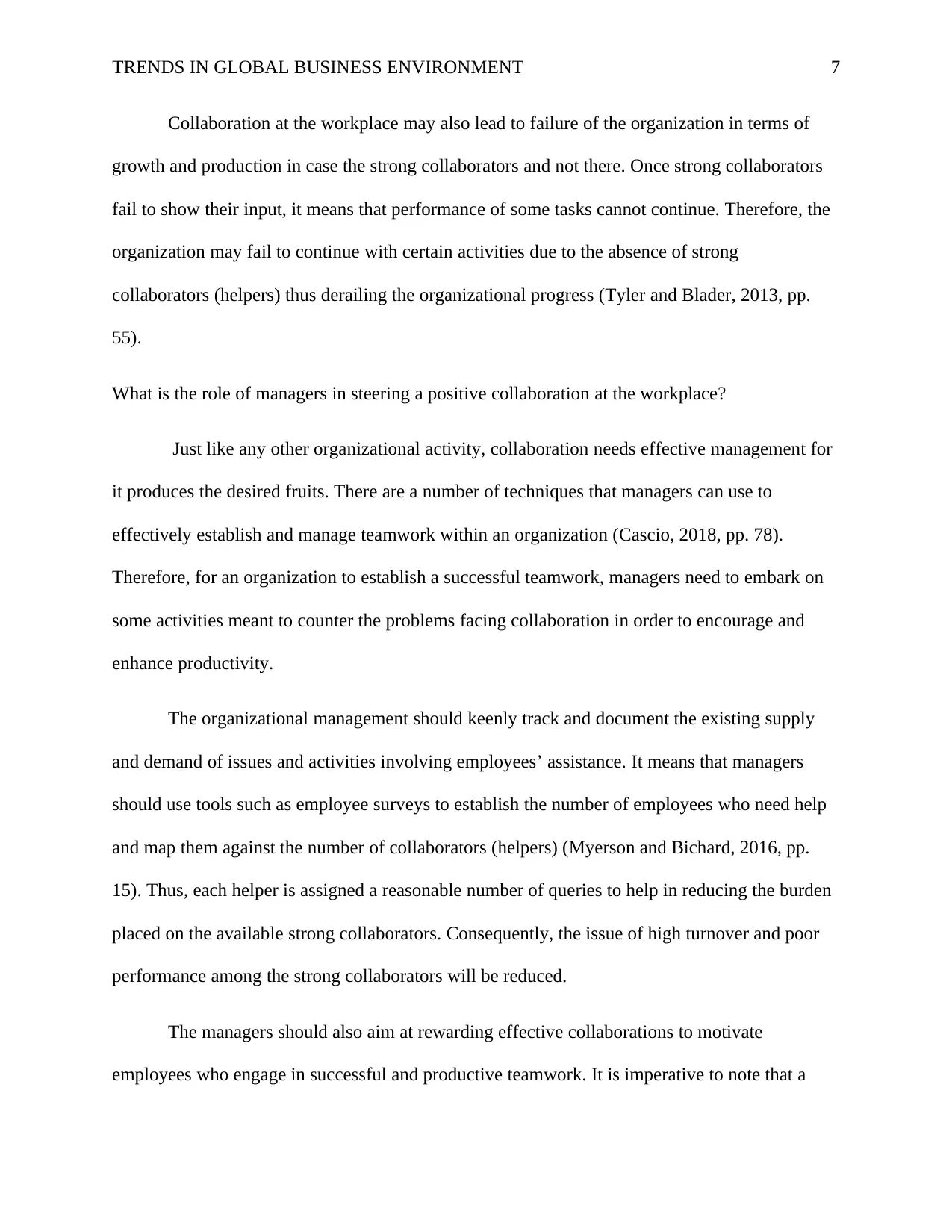
TRENDS IN GLOBAL BUSINESS ENVIRONMENT 7
Collaboration at the workplace may also lead to failure of the organization in terms of
growth and production in case the strong collaborators and not there. Once strong collaborators
fail to show their input, it means that performance of some tasks cannot continue. Therefore, the
organization may fail to continue with certain activities due to the absence of strong
collaborators (helpers) thus derailing the organizational progress (Tyler and Blader, 2013, pp.
55).
What is the role of managers in steering a positive collaboration at the workplace?
Just like any other organizational activity, collaboration needs effective management for
it produces the desired fruits. There are a number of techniques that managers can use to
effectively establish and manage teamwork within an organization (Cascio, 2018, pp. 78).
Therefore, for an organization to establish a successful teamwork, managers need to embark on
some activities meant to counter the problems facing collaboration in order to encourage and
enhance productivity.
The organizational management should keenly track and document the existing supply
and demand of issues and activities involving employees’ assistance. It means that managers
should use tools such as employee surveys to establish the number of employees who need help
and map them against the number of collaborators (helpers) (Myerson and Bichard, 2016, pp.
15). Thus, each helper is assigned a reasonable number of queries to help in reducing the burden
placed on the available strong collaborators. Consequently, the issue of high turnover and poor
performance among the strong collaborators will be reduced.
The managers should also aim at rewarding effective collaborations to motivate
employees who engage in successful and productive teamwork. It is imperative to note that a
Collaboration at the workplace may also lead to failure of the organization in terms of
growth and production in case the strong collaborators and not there. Once strong collaborators
fail to show their input, it means that performance of some tasks cannot continue. Therefore, the
organization may fail to continue with certain activities due to the absence of strong
collaborators (helpers) thus derailing the organizational progress (Tyler and Blader, 2013, pp.
55).
What is the role of managers in steering a positive collaboration at the workplace?
Just like any other organizational activity, collaboration needs effective management for
it produces the desired fruits. There are a number of techniques that managers can use to
effectively establish and manage teamwork within an organization (Cascio, 2018, pp. 78).
Therefore, for an organization to establish a successful teamwork, managers need to embark on
some activities meant to counter the problems facing collaboration in order to encourage and
enhance productivity.
The organizational management should keenly track and document the existing supply
and demand of issues and activities involving employees’ assistance. It means that managers
should use tools such as employee surveys to establish the number of employees who need help
and map them against the number of collaborators (helpers) (Myerson and Bichard, 2016, pp.
15). Thus, each helper is assigned a reasonable number of queries to help in reducing the burden
placed on the available strong collaborators. Consequently, the issue of high turnover and poor
performance among the strong collaborators will be reduced.
The managers should also aim at rewarding effective collaborations to motivate
employees who engage in successful and productive teamwork. It is imperative to note that a
Paraphrase This Document
Need a fresh take? Get an instant paraphrase of this document with our AI Paraphraser
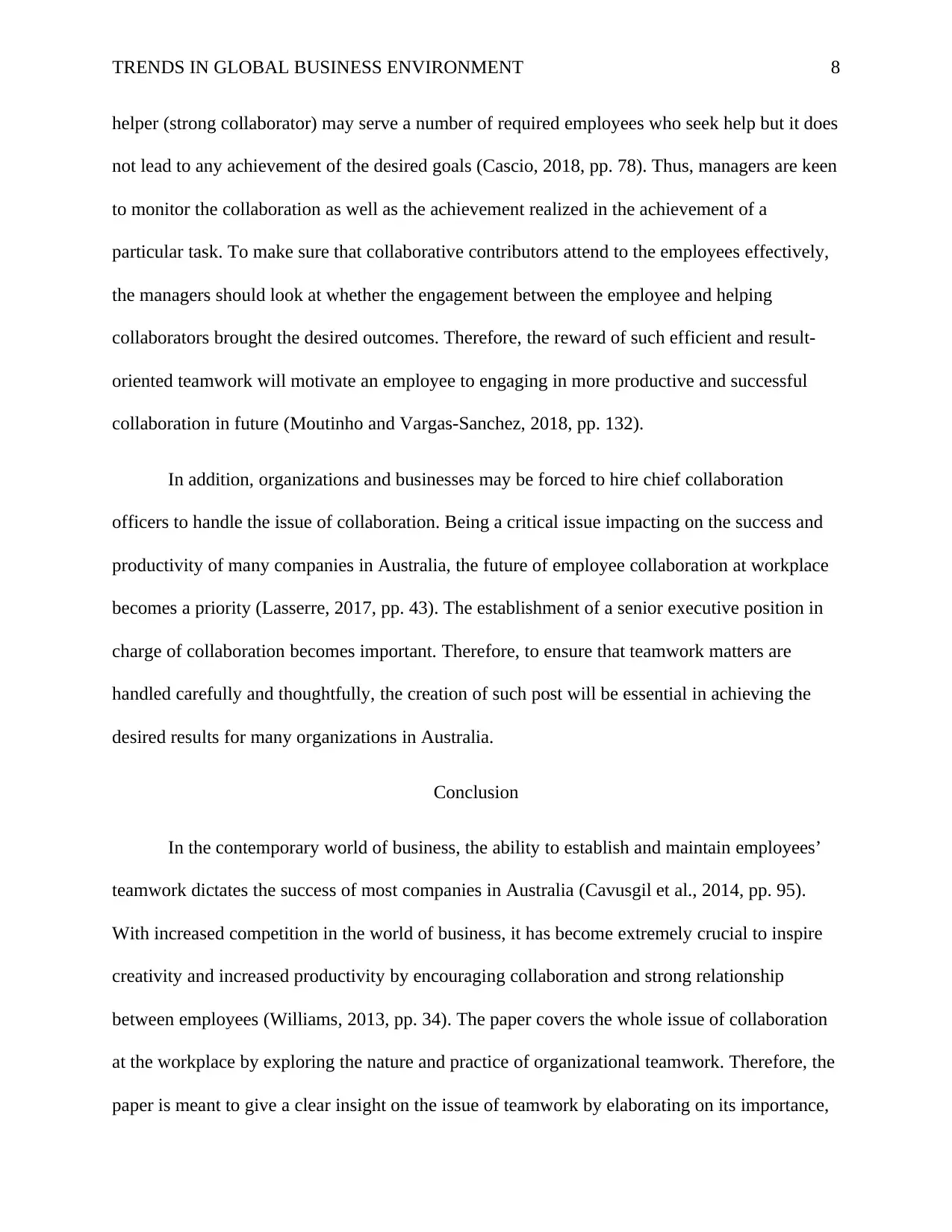
TRENDS IN GLOBAL BUSINESS ENVIRONMENT 8
helper (strong collaborator) may serve a number of required employees who seek help but it does
not lead to any achievement of the desired goals (Cascio, 2018, pp. 78). Thus, managers are keen
to monitor the collaboration as well as the achievement realized in the achievement of a
particular task. To make sure that collaborative contributors attend to the employees effectively,
the managers should look at whether the engagement between the employee and helping
collaborators brought the desired outcomes. Therefore, the reward of such efficient and result-
oriented teamwork will motivate an employee to engaging in more productive and successful
collaboration in future (Moutinho and Vargas-Sanchez, 2018, pp. 132).
In addition, organizations and businesses may be forced to hire chief collaboration
officers to handle the issue of collaboration. Being a critical issue impacting on the success and
productivity of many companies in Australia, the future of employee collaboration at workplace
becomes a priority (Lasserre, 2017, pp. 43). The establishment of a senior executive position in
charge of collaboration becomes important. Therefore, to ensure that teamwork matters are
handled carefully and thoughtfully, the creation of such post will be essential in achieving the
desired results for many organizations in Australia.
Conclusion
In the contemporary world of business, the ability to establish and maintain employees’
teamwork dictates the success of most companies in Australia (Cavusgil et al., 2014, pp. 95).
With increased competition in the world of business, it has become extremely crucial to inspire
creativity and increased productivity by encouraging collaboration and strong relationship
between employees (Williams, 2013, pp. 34). The paper covers the whole issue of collaboration
at the workplace by exploring the nature and practice of organizational teamwork. Therefore, the
paper is meant to give a clear insight on the issue of teamwork by elaborating on its importance,
helper (strong collaborator) may serve a number of required employees who seek help but it does
not lead to any achievement of the desired goals (Cascio, 2018, pp. 78). Thus, managers are keen
to monitor the collaboration as well as the achievement realized in the achievement of a
particular task. To make sure that collaborative contributors attend to the employees effectively,
the managers should look at whether the engagement between the employee and helping
collaborators brought the desired outcomes. Therefore, the reward of such efficient and result-
oriented teamwork will motivate an employee to engaging in more productive and successful
collaboration in future (Moutinho and Vargas-Sanchez, 2018, pp. 132).
In addition, organizations and businesses may be forced to hire chief collaboration
officers to handle the issue of collaboration. Being a critical issue impacting on the success and
productivity of many companies in Australia, the future of employee collaboration at workplace
becomes a priority (Lasserre, 2017, pp. 43). The establishment of a senior executive position in
charge of collaboration becomes important. Therefore, to ensure that teamwork matters are
handled carefully and thoughtfully, the creation of such post will be essential in achieving the
desired results for many organizations in Australia.
Conclusion
In the contemporary world of business, the ability to establish and maintain employees’
teamwork dictates the success of most companies in Australia (Cavusgil et al., 2014, pp. 95).
With increased competition in the world of business, it has become extremely crucial to inspire
creativity and increased productivity by encouraging collaboration and strong relationship
between employees (Williams, 2013, pp. 34). The paper covers the whole issue of collaboration
at the workplace by exploring the nature and practice of organizational teamwork. Therefore, the
paper is meant to give a clear insight on the issue of teamwork by elaborating on its importance,
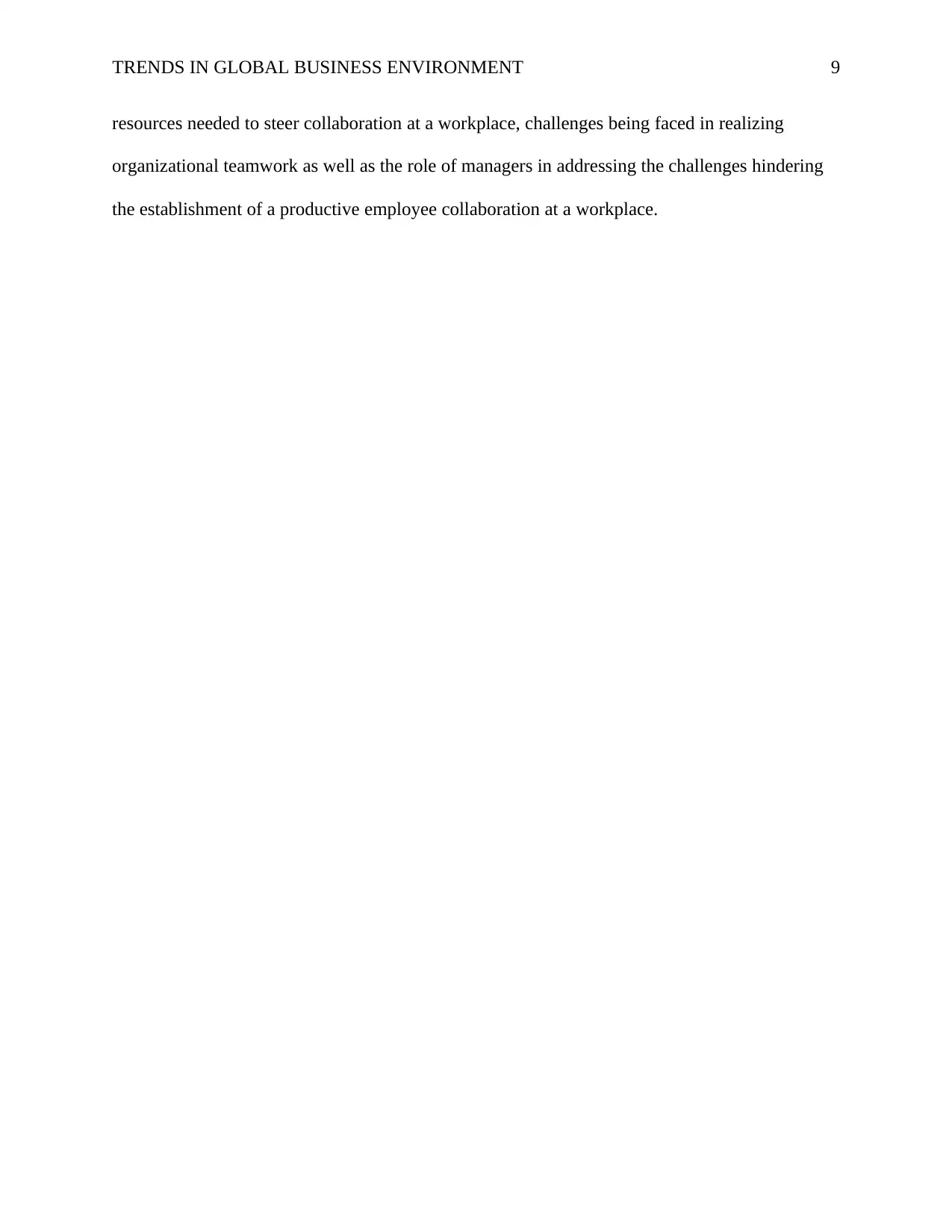
TRENDS IN GLOBAL BUSINESS ENVIRONMENT 9
resources needed to steer collaboration at a workplace, challenges being faced in realizing
organizational teamwork as well as the role of managers in addressing the challenges hindering
the establishment of a productive employee collaboration at a workplace.
resources needed to steer collaboration at a workplace, challenges being faced in realizing
organizational teamwork as well as the role of managers in addressing the challenges hindering
the establishment of a productive employee collaboration at a workplace.
⊘ This is a preview!⊘
Do you want full access?
Subscribe today to unlock all pages.

Trusted by 1+ million students worldwide
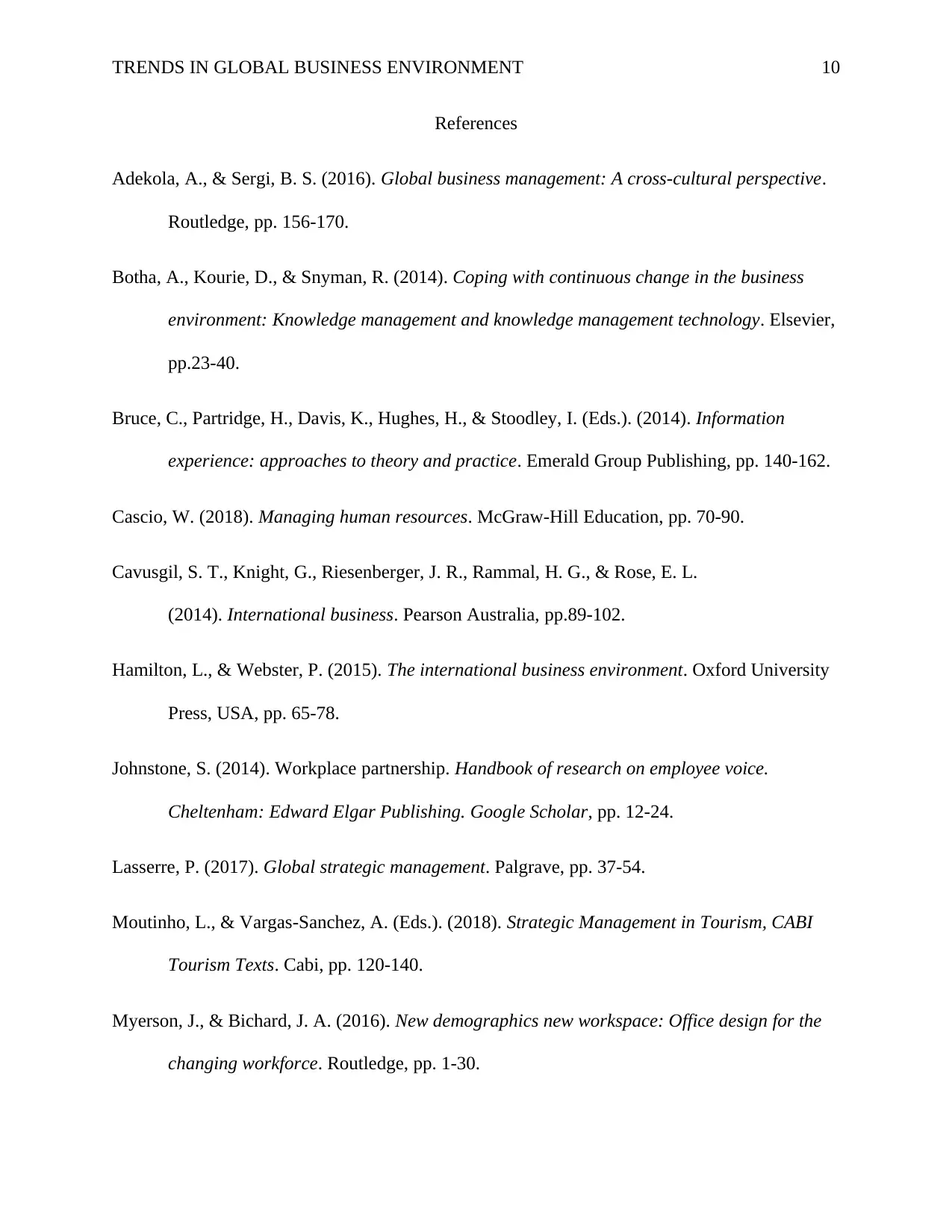
TRENDS IN GLOBAL BUSINESS ENVIRONMENT 10
References
Adekola, A., & Sergi, B. S. (2016). Global business management: A cross-cultural perspective.
Routledge, pp. 156-170.
Botha, A., Kourie, D., & Snyman, R. (2014). Coping with continuous change in the business
environment: Knowledge management and knowledge management technology. Elsevier,
pp.23-40.
Bruce, C., Partridge, H., Davis, K., Hughes, H., & Stoodley, I. (Eds.). (2014). Information
experience: approaches to theory and practice. Emerald Group Publishing, pp. 140-162.
Cascio, W. (2018). Managing human resources. McGraw-Hill Education, pp. 70-90.
Cavusgil, S. T., Knight, G., Riesenberger, J. R., Rammal, H. G., & Rose, E. L.
(2014). International business. Pearson Australia, pp.89-102.
Hamilton, L., & Webster, P. (2015). The international business environment. Oxford University
Press, USA, pp. 65-78.
Johnstone, S. (2014). Workplace partnership. Handbook of research on employee voice.
Cheltenham: Edward Elgar Publishing. Google Scholar, pp. 12-24.
Lasserre, P. (2017). Global strategic management. Palgrave, pp. 37-54.
Moutinho, L., & Vargas-Sanchez, A. (Eds.). (2018). Strategic Management in Tourism, CABI
Tourism Texts. Cabi, pp. 120-140.
Myerson, J., & Bichard, J. A. (2016). New demographics new workspace: Office design for the
changing workforce. Routledge, pp. 1-30.
References
Adekola, A., & Sergi, B. S. (2016). Global business management: A cross-cultural perspective.
Routledge, pp. 156-170.
Botha, A., Kourie, D., & Snyman, R. (2014). Coping with continuous change in the business
environment: Knowledge management and knowledge management technology. Elsevier,
pp.23-40.
Bruce, C., Partridge, H., Davis, K., Hughes, H., & Stoodley, I. (Eds.). (2014). Information
experience: approaches to theory and practice. Emerald Group Publishing, pp. 140-162.
Cascio, W. (2018). Managing human resources. McGraw-Hill Education, pp. 70-90.
Cavusgil, S. T., Knight, G., Riesenberger, J. R., Rammal, H. G., & Rose, E. L.
(2014). International business. Pearson Australia, pp.89-102.
Hamilton, L., & Webster, P. (2015). The international business environment. Oxford University
Press, USA, pp. 65-78.
Johnstone, S. (2014). Workplace partnership. Handbook of research on employee voice.
Cheltenham: Edward Elgar Publishing. Google Scholar, pp. 12-24.
Lasserre, P. (2017). Global strategic management. Palgrave, pp. 37-54.
Moutinho, L., & Vargas-Sanchez, A. (Eds.). (2018). Strategic Management in Tourism, CABI
Tourism Texts. Cabi, pp. 120-140.
Myerson, J., & Bichard, J. A. (2016). New demographics new workspace: Office design for the
changing workforce. Routledge, pp. 1-30.
Paraphrase This Document
Need a fresh take? Get an instant paraphrase of this document with our AI Paraphraser
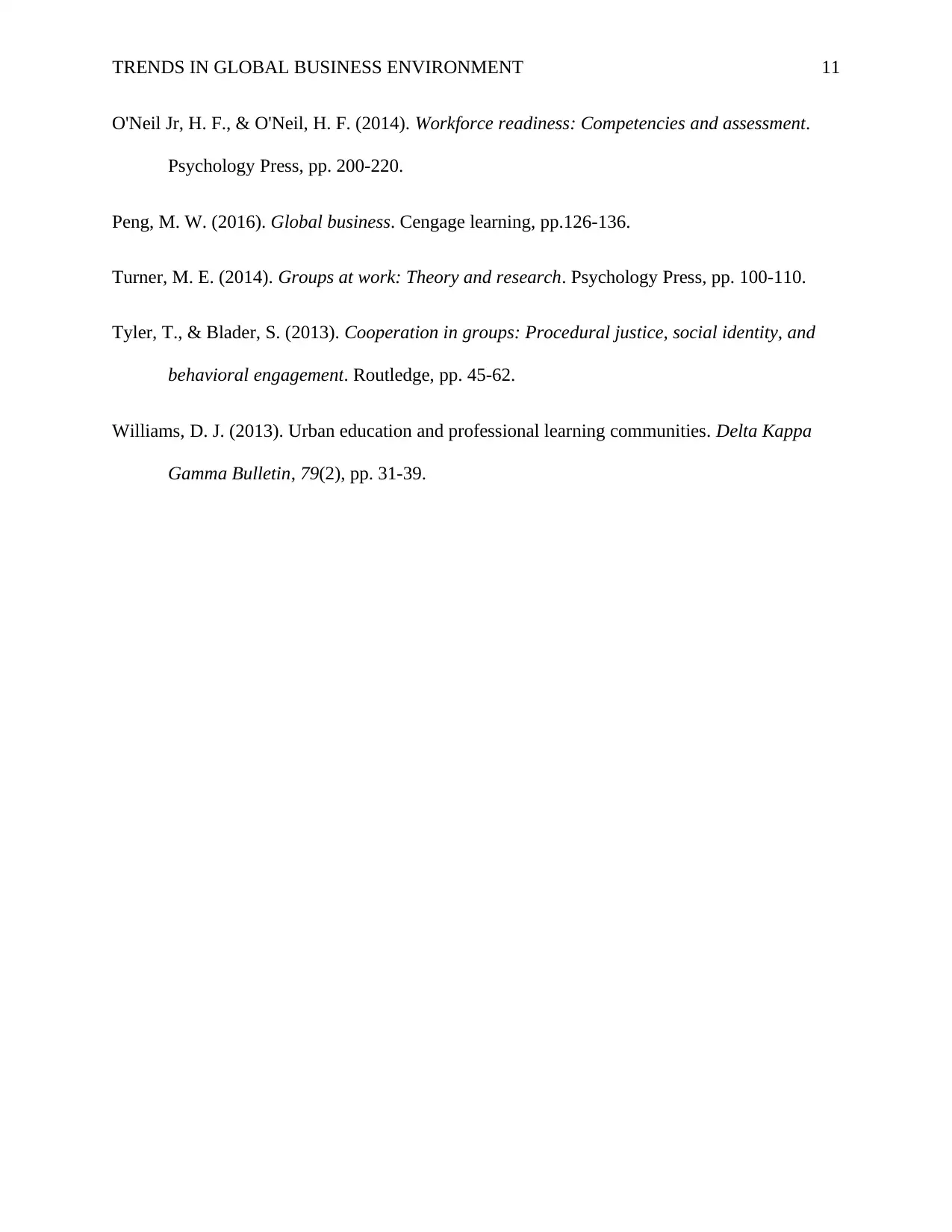
TRENDS IN GLOBAL BUSINESS ENVIRONMENT 11
O'Neil Jr, H. F., & O'Neil, H. F. (2014). Workforce readiness: Competencies and assessment.
Psychology Press, pp. 200-220.
Peng, M. W. (2016). Global business. Cengage learning, pp.126-136.
Turner, M. E. (2014). Groups at work: Theory and research. Psychology Press, pp. 100-110.
Tyler, T., & Blader, S. (2013). Cooperation in groups: Procedural justice, social identity, and
behavioral engagement. Routledge, pp. 45-62.
Williams, D. J. (2013). Urban education and professional learning communities. Delta Kappa
Gamma Bulletin, 79(2), pp. 31-39.
O'Neil Jr, H. F., & O'Neil, H. F. (2014). Workforce readiness: Competencies and assessment.
Psychology Press, pp. 200-220.
Peng, M. W. (2016). Global business. Cengage learning, pp.126-136.
Turner, M. E. (2014). Groups at work: Theory and research. Psychology Press, pp. 100-110.
Tyler, T., & Blader, S. (2013). Cooperation in groups: Procedural justice, social identity, and
behavioral engagement. Routledge, pp. 45-62.
Williams, D. J. (2013). Urban education and professional learning communities. Delta Kappa
Gamma Bulletin, 79(2), pp. 31-39.
1 out of 11
Related Documents
Your All-in-One AI-Powered Toolkit for Academic Success.
+13062052269
info@desklib.com
Available 24*7 on WhatsApp / Email
![[object Object]](/_next/static/media/star-bottom.7253800d.svg)
Unlock your academic potential
Copyright © 2020–2025 A2Z Services. All Rights Reserved. Developed and managed by ZUCOL.





